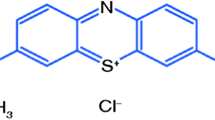Abstract
Experiments on the removal and recovery of U(VI) from aqueous solution by tea waste were conducted. The adsorbent was characterized by scanning electron microscope and energy dispersive spectrometer before and after the adsorption treatment. The removal of U(VI) amounts to 86.80 % at optimum pH 6. The adsorption process reaches its equilibrium in 12 h at 308 K, and the kinetic characteristic can be described by the pseudo-second-order kinetic equation. The amount of adsorption increases from 22.92 to 142.21 mg g−1 with the decrease of tea waste dosage from 100 to 10 mg for solution with an initial uranium concentration of 50 mg L−1. Desorption for the four strippants is higher than 80 %. The equilibrium data are more agreeable with Freundlich isotherm than Langmuir isotherm.









Similar content being viewed by others
References
Kazy SK, D’Souza SF, Sar P (2009) Uranium and thorium sequestration by a Pseudomonas sp.: mechanism and chemical characterization. J Hazard Mater 163:65–72
Pang C, Liu YH, Cao XH, Li M, Huang GL, Hua R, Wang CX, Liu YT, An XF (2011) Biosorption of uranium (VI) from aqueous solution by dead fungal biomass of Penicillium citrinum. Chem Eng J 170:1–6
Khambhaty Y, Mody K, Basha S, Jha B (2009) Kinetics, equilibrium and thermodynamic studies on biosorption of hexavalent chromium by dead fungal biomass of marine Aspergillus niger. Chem Eng J 145:489–495
Yang J, Volesky B (1999) Biosorption of uranium on Sargassum biomass. Water Res 33:3357–3363
Tsuruta T (2011) Biosorption of uranium for environmental applications using bacteria isolated from the uranium deposits. J Radioanal Nucl Chem 267–281
Wang JS, Hu XJ, Liu YG, Xie SB, Bao ZL (2010) Biosorption of uranium (VI) by immobilized Aspergillus fumigates beads. J Environ Radioact 101:504–508
Akhtar K, Akhtar MW, Khalid AM (2007) Removal and recovery of uranium from aqueous solutions by Trichoderma harzianum. Water Res 41:1366–1378
Liu MX, Dong FQ, Yan XY, Zeng WM, Hou LY, Pang XF (2010) Biosorption of uranium by Saccharomyces cerevisiae and surface interactions under culture conditions. Bioresour Technol 101:8573–8580
Bai J, Yao HJ, Fan FL, Lin MS, Zhang LN, Ding HJ, Lei FA, Wu XL, Li XF, Guo JS, Qin Z (2010) Biosorption of uranium by chemically modified Rhodotorula glutinis. J Environ Radioact 101:969–973
Bhat SV, Melo JS, Chaugule BB, D’Souza SF (2008) Biosorption characteristics of uranium (VI) from aqueous medium onto Catenella repens, a red alga. J Hazard Mater 158:628–635
Khani MH, Keshtkar AR, Ghannadi M, Pahlavanzadeh H (2008) Equilibrium, kinetic and thermodynamic study of the biosorption of uranium onto Cystoseira indica algae. J Hazard Mater 150:612–618
Wasewar KL, Atif M, Prasad B, Indra MM (2008) Adsorption of zinc using tea factory waste: kinetics, equilibrium and thermodynamics. Clean Soil 36:320–329
Yoshita A, Lu JL, Ye JH, Liang YR (2009) Sorption of lead from aqueous solutions by spent tea leaf. Afr J Biotechnol 8:2212–2217
Nishino N, Kawai T, Kondo M (2007) Changes during ensilage in fermentation products, tea catechins, antioxidative activity and in vitro gas production of green tea waste stored with or without dried beet pulp. J Sci Food Agr 87:1639–1644
Hargreaves J, Adl MS, Warman PR, Rupasinghe HPV (2008) The effects of organic amendments on mineral element up take and fruit quality of raspberries. Plant Soil 308:213–226
Uddin MT, Islam MA, Mahmud S, Rukanuzzaman MD (2009) Adsorptive removal of methylene blue by tea waste. J Hazard Mater 164:53–60
Hameed BH (2009) Spent tea leaves: a new non-conventional and low-cost adsorbent for removal of basic dye from aqueous solutions. J Hazard Mater 161:753–759
Ersoy S, Kucuk H (2009) Investigation of industrial tea-leaf-fiber waste material for its sound adsorption properties. Appl Acoust 70:215–220
Mohammad AH, Mikio K, Yoshimasa M, Shigeru M (2005) Optimization of parameters for Cr (VI) adsorption on used black tea leaves. Adsorption 11:561–568
Malkoc E, Nuhoglu Y (2006) Fixed bed studies for the sorption of chromium (VI) onto tea factory waste. Chem Eng Sci 61:4363–4372
Mozumder MSI, Khan MMR, Islam MA (2008) Kinetics and mechanism of Cr (VI) adsorption onto tea-leaves waste. Asia Pac J Chem Eng 3:452–458
Amarasinghe BMWPK, Williams RA (2007) Tea waste as a low cost adsorbent for the removal of Cu and Pb from wastewater. Chem Eng J 132:299–309
Yang BY, Feng YH (2004) Progress on the behavior of tealeaf in catching metallic ions such as gold and silver contained in water. Gold 25:43–47
Gok C, Aytas S (2009) Biosorption of uranium (VI) from aqueous solution using calcium alginate beads. J Hazard Mater 168:369–375
Akhtar K, Akhtar MW, Khalid AM (2007) Removal and recovery of uranium from aqueous solutions by Trichoderma harzianum. Water Res 41:1366–1378
Parab H, Joshi S, Shenoy N, Verma R, Lali A, Sudersanan M (2005) Uranium removal from aqueous solution by coir pith: equilibrium and kinetic studies. Bioresour Technol 96:1241–1248
Barnett MO, Jardine PM, Brooks SC, Selim HM (2000) Adsorption and transport of uranium (VI) in subsurface media. Soil Sci Soc Am J 64:908–917
Malkoc E, Nuhoglu Y (2005) Investigations of nickel (II) removal from aqueous solutions using tea factory waste. J Hazard Mater 127:120–128
Gerente C, Lee VKC, Cloirec PL, Mckay G (2007) Application of chitosan for the removal of metals from wastewaters by adsorption- mechanisms and models review. Crit Rev Env Sci Tec 37:41–127
Popa K, Cecal A, Drochioiu G, Pui A, Humelnicu D (2003) Saccharomyces cerevisiae as uranium bioaccumulating material: the influence of contact time, pH and anion nature. Nukleonika 48:121–125
Acknowledgments
This research was supported by the National Natural Science Foundation of China (grant No. 50774047), Scientific Research Foundation of Education Department (grant No. 10A103 and grant No. 10C1134) and Science and Technology Department (grant No. 2010GK2025) of Hunan Province.
Author information
Authors and Affiliations
Corresponding author
Rights and permissions
About this article
Cite this article
Ding, DX., Liu, XT., Hu, N. et al. Removal and recovery of uranium from aqueous solution by tea waste. J Radioanal Nucl Chem 293, 735–741 (2012). https://doi.org/10.1007/s10967-012-1866-z
Received:
Published:
Issue Date:
DOI: https://doi.org/10.1007/s10967-012-1866-z




